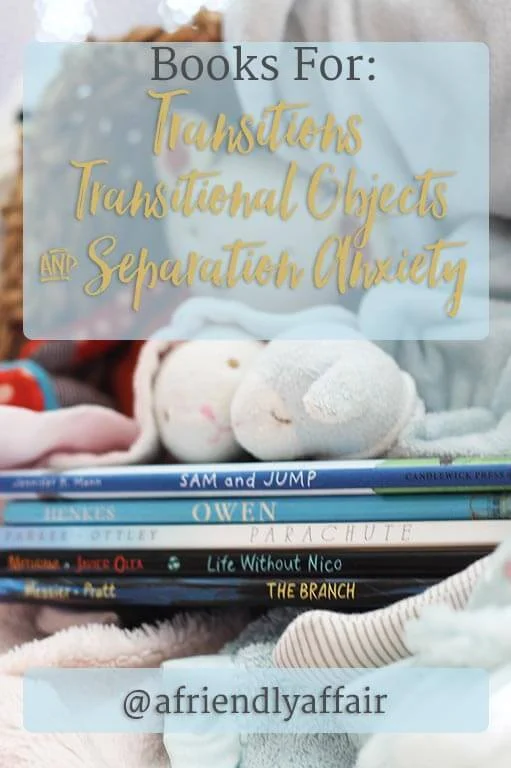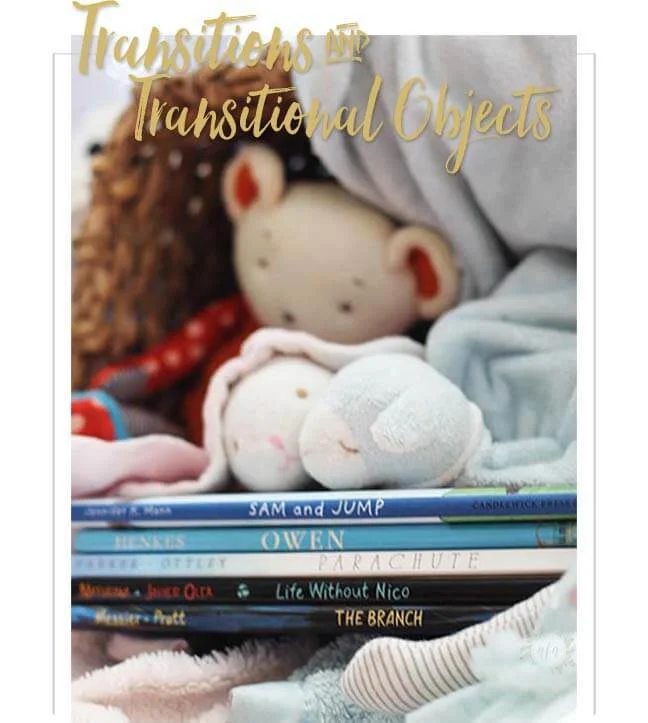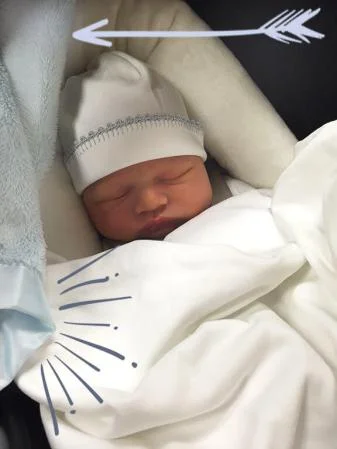Transitions with Children
Attachment Objects + Children: How to use them Well
People are sending their kids off for first days and first weeks all the time, and without variation, we share the same question: What in the heck is my child going to do or become when I leave her for the first time?
The answer is simple: They will adapt.
The trick, of course, is making the adjustment run smoothly and causing as little trauma (for mama and baby) as possible.
The ingredients for a smooth transition are as many and as variable as the children themselves. But one common element, shared by most if not all, is the “object of attachment” or the “first possession.” I have heard parents call it a “security blanket.” Mamas are always confused when I start asking questions about their child’s blankie, lovey, bunny, bear, whatever. And yet, so crucial is the object to the child’s maturational process, that it is actually called (by psychologists and specialists) the TRANSITIONAL OBJECT. So few mothers understand what it is, how to use it, or why the child needs it, which is a bummer. Knowing what that blankie actually is and how to deal with/use it will seriously make your life so much better!
I have included a list of my favorite picture books featuring transitional objects. I think these books are wonderful for helping adults bear witness to the the drama of childhood attachment, transition, and object love.
But first, a story…
At 10 months, my daughter took her first possession – a blanket. She came home the first day of daycare, picked up the blanket I had been toting around for the last 10 months, and made it her own. She didn’t carry it everywhere, but if it was out of her reach, or she couldn’t get to it, she would get angry. She took it from room to room, outside to inside. I instructed the daycare workers about the nature of the object and how to allow it or use it as a tool. My daughter used the object for two months and then forgot about it. Around 14 months I went out of town for the first time – for almost two weeks. Having not considered her blanket much for the past few months, she took it up again, carrying it and controlling it, making sure it was reachable and visible at all times.
That blanket helped my daughter transition to daycare and later to my absence.
It was a symbol of me, yet it was controlled by her. When you’re child is transitioning, it helps if they have something that they can control. There are a LOT of reasons for this, but consider that changing caregivers is a feeling of utter helplessness for the child. Among other things, that blanket was something soft and cuddly with which my daughter could play and manage. It was a helpful antidote to the impinging changes and separation anxiety.
Transitional objects are themselves transitional. As the child is navigating from always having the mother to being separated from her, the blanket is a very important half-way point. In children who are still at home full time, you might notice the use of a lovey during nap or at night. It helps them tolerate the separation by creating a short-lived but important illusion that separation isn’t complete. So when I hear that a daycare doesn’t allow lovies – even if only for the first month of day care – I want to barf.
what is the object?
The transitional object, like play, is used to help the child’s internal world expand to include separation (from the mother) without giving up all the love, attachment, and comfort that preceded it. Psychologists generally agree that it is a symbol of the union between mother and child and yet it has a place and time; it is tangible and controllable. I have heard psychoanalysts call it the “faithful protective escort,” which I think has a lovely, heroic ring to it. It comes when it is needed most and should definitely be allowed by the caregivers.
Your kiddo’s lovey aids growth and individuation while providing them the illusion of control, and safety – two things which are crucial in easing transitions. It allays the separation anxiety caused by sleeping, and it is also a useful tool when transitioning through another period of separation anxiety, like moving to a new caregiver. Again, with the barfing when a daycare say no.
how do i use it to my advantage?
Simple. Allow it. Facilitate it. The child must have complete ownership and dominance over it. It must provide the experience of warmth and cuddling. The assumption of dominance is critical and should be taken seriously. This is the part that I think most caregivers forget or don’t realize. When my daughter was still in daycare and I would arrive to pick her up, sometimes the blanket would be folded, put high up and out of her reach on a shelf. This would make me so angry (a lecture and a printed hand out, angry). The child needs to feel that she is in control of that thing. When it is folded and put on a shelf out of her reach, that illusion is ruptured, which is a real loss.
What do I mean facilitate the object? With both my children, I chose a very soft 18 x 18 inch blanket before they were born, and anytime we were together, I had that blanket on me, on him, on her. That blanket was me and I was that blanket. I have included a picture of my son about to leave the hospital as proof (notice the blanket?)
I can’t tell you how many times this has saved me. When I am cooking dinner or when I am leaving the room for nap, that blanket is everything. When I am dropping my kid off at daycare, and I see him start rubbing his face with that blanket, all will be well. When I was out of town and my husband reported that my daughter was fine, “except she is obsessing over the blanket again,” I knew we had dodged a bullet. She was learning; I knew she was self soothing and growing.
Transitional objects are important and worthy of your attention.
If the day school doesn’t allow it, fight the good fight, see if you can’t help them understand why the object is a valuable tool. If your child is having trouble with separation in general, see if you can ease the burden of attachment by spreading it to an object that will help the child accept their independence and your separateness. The realization of a mother’s separateness is in many ways a child’s first trauma. It is also a child’s first vital accomplishment and it should not be avoided. You can introduce or encourage attachment to an object that will make the transition easier for everyone involved.
For more in depth review of these books follow my Instagram @afriendlyaffair – To see the Amazon reviews and to order, click the titles. They are affiliate links, so I get a little commission to maintain the site, at no charge to you.
Sam and Jump by Jennifer Mann // Candlewick – A young boy loses a beloved bunny and finds a friend. Pay attention to how the bunny’s necessity waxes and wanes with the childs needs
Parachute by Danny Parker and Matt Ottley // Erdmans – The Amazon reviews say this is a story about a young boy who conquers his fear of heights but actually, this is a classic story of every child, trying to mature, and using an object to make the transition easier. The way the child comforts himself and uses the parachute when needed, then quietly moves on once he accomplishes the maturational leap is a testament to the author’s brilliant insight about child development.
Owen by Kevin Henkes // Greenwillow – A sweet story about one family that finds a creative solution to a child’s need for his blanket despite his age and new school.
The Branch by Mirielle Messier and Pierre Pratt // Kids Can Press – Not every transitional experience is an object. Sometimes it is a place or a play thing. In this case it is a tree branch, and when that branch breaks, we witness one child’s anxiety and her creative solution. A great book that testifies to the importance of a child’s play and the fact that a child at play is often accomplishing something more transformative and important than we can tell.
The Invisible String by Patrice Karst – A special read about the invisible thread that binds mother to child. Surely a great conversation starter that might provide helpful language to a child that is dealing with separation anxiety and fear.
Jack’s Worry by Sam Zuppardi // Candlewick – Wow, yes, do it. Not every anxiety has to do with separation, maybe it is a different kind of transition. Maybe it is a darkness or a fear for which your child can’t verbalize. This book again, is a helpful conversation starter and a brilliant invitation for the parent to be hospitble and available to the child’s scariest emotions.






